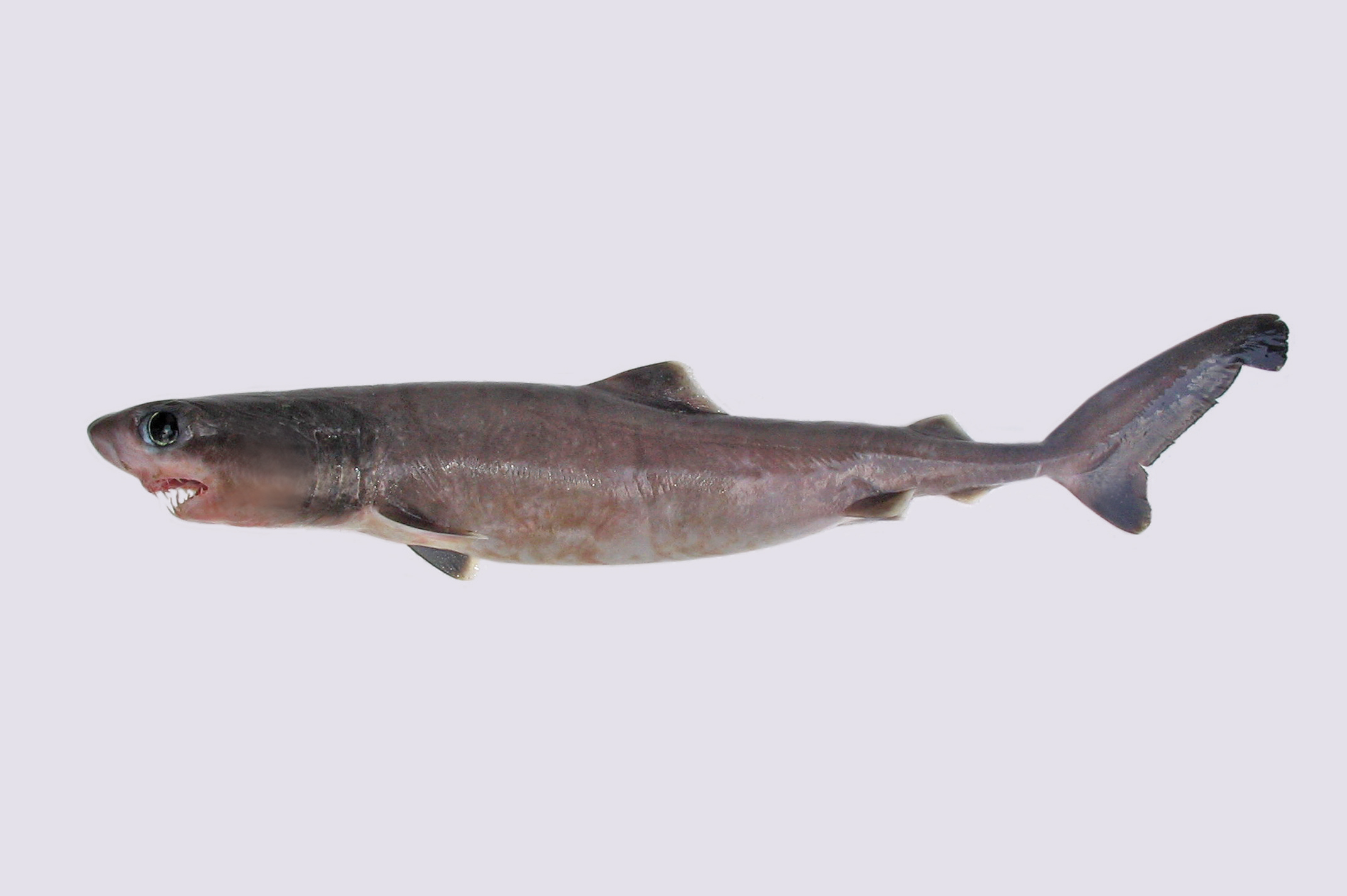Crocodile Shark, Pseudocarcharias kamoharai (Matsubara 1936)

A Crocodile Shark, Pseudocarcharias kamoharai, from off north Westarn Australia. Source: Martin Gomon / Museum Victoria. License: CC BY-Attribution
The Crocodile Shark has very large eyes that lack a nictitating membrane, and long gill slits that extend onto dorsal half of the head. The large mouth has protrusible jaws that reach beyond the eyes, with long spike-like teeth at the front and dagger-like teeth further back. They feed on mesopelagic fishes, crustaceans and squid.
Crocodile Shark, Pseudocarcharias kamoharai (Matsubara 1936)
More Info
|
Distribution |
Recorded in Australia from off Western Australia, Queensland and New South Wales. Elsewhere the species is circumglobal in tropical and subtropical waters. Crocodile sharks inhabit epi- and mesopelagic depths to 600 metres. The species may undertake vertical migrations to feed in near surface waters at night. |
|
Features |
Head short, snout pointed, eye large, diameter 3.6-4.9% precaudal length; gill openings extending onto dorsal half of head; two dorsal fins, the first twice the size of the second; anal-fin base shorter than half length of first dorsal-fin base; pectoral and pelvic fins broad and rounded. |
|
Size |
Maximum length 110 cm. |
|
Colour |
Dark brown above, paler below, often with a few dark blotches on the sides, a white mark in front of the first gill slit, and fins with whitish margins. |
|
Feeding |
Feeds on fishes, crustaceans and squids. |
|
Biology |
Crocodile sharks are relatively fast growing with males achieving first maturity at 3·1 years and females at 5·1 years, with pregnancy appearing at 4·8 years. The species is aplacental viviparous (ovoviviparous), with embryos engaging in oophagy, where the largest embryos feed on other eggs in the uterus. Females have litters of 4 pups which measure 40 cm at birth. Females mature by about 90 cm, and males by about 75 cm. |
|
Fisheries |
Taken as bycatch in pelagic longline fisheries, and occasionally in pelagic gill net fisheries. |
|
Conservation |
IUCN Red List: Near Threatened |
|
Remarks |
|
|
Similar Species |
|
|
Etymology |
The common name, Crocodile Shark, is from its habit of rapidly snapping its jaws when caught and taken aboard ship. |
|
Species Citation |
|
|
Author |
Bray, D.J. 2017 |
|
Resources |
Crocodile Shark, Pseudocarcharias kamoharai (Matsubara 1936)
References
Compagno, L.J.V. 1984. FAO Species Catalogue. Sharks of the World. An annotated and illustrated catalogue of shark species known to date. Hexanchiformes to Lamniformes. FAO Fisheries Synopsis No. 125. Rome : FAO Vol. 4(1) pp. 1-249.
Compagno, L.J.V. 1998. Families Pseudocarchariidae, Alopiidae, Lamnidae. pp. 1268-1278 in Carpenter, K.E. & Niem, V.H. (eds). The Living Marine Resources of the Western Central Pacific. FAO Species Identification Guide for Fisheries Purposes. Rome : FAO Vol. 2 687-1396 pp.
Compagno, L.J.V. 2001. Sharks of the World. An annotated and illustrated catalogue of shark species known to date. Bullhead, mackerel and carpet sharks (Heterodontiformes, Lamniformes and Orectolobiformes). Rome : FAO, FAO Species Catalogue for Fisheries Purposes No. 1 Vol. 2 269 pp.
Compagno, L.J.V., Dando, M. & Fowler, S. 2005. A Field Guide to the Sharks of the World. London : Collins 368 pp.
Compagno, L.J.V. & Musick, J.A. 2005. Pseudocarcharias kamoharai. In: IUCN 2012. IUCN Red List of Threatened Species. Version 2012.1. <www.iucnredlist.org>. Downloaded on 09 July 2012.Fujita, K. 1981. Oviphagous embryos of the pseudocarchariid shark, Pseudocarcharias kamoharai, from the central Pacific. Japanese Journal of Ichthyology 28(1): 37–44.
Last, P.R. & Stevens, J.D. 1994. Sharks and Rays of Australia. Canberra : CSIRO Australia 513 pp. 84 pls
Last, P.R. & Stevens, J.D. 2009. Sharks and Rays of Australia. Collingwood : CSIRO Publishing Australia 2, 550 pp.
Lessa, R., Andrade, H.A., De Lima, K.L. & Santana, F.M. 2015. Age and growth of the midwater crocodile shark Pseudocarcharias kamoharai. Journal of Fish Biology. doi: 10.1111/jfb.12717 Abstract
Matsubara, K. 1936. A new carcharoid shark found in Japan. Zoological Magazine, Tokyo 48(7): 380-382.
Pepperell, J. 2010. Fishes of the Open Ocean a Natural History & Illustrated Guide. Sydney : University of New South Wales Press Ltd 266 pp.
Stewart, A. 2001. First record of the crocodile shark, Pseudocarcharias kamoharai (Chondrichthys: Lamniformes), from New Zealand waters. New Zealand Journal of Marine and Freshwater Research 35: 1001-1006
White, W. 2008. Shark Families Heterodontidae to Pristiophoridae. pp. 32-100 in Gomon. M.F., Bray, D.J. & Kuiter, R.H (eds). Fishes of Australia's Southern Coast. Sydney : Reed New Holland 928 pp.


